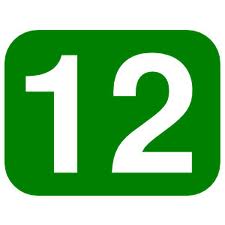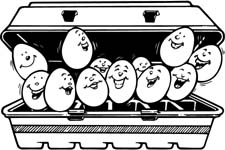Apostles, Mill-Clappers, and Zodiac Signs (And The Common Thread Is … the Number 12) Posted by róislín on Jan 29, 2014 in Irish Language
(le Róislín)
 You may have noticed that both “dhéag” and “déag” were used in the last blog title (nasc thíos). For “twelve animals,” we said “dhá ainmhí dhéag” with the lenited form “dhéag” [yayg]. For “twelve years,” we said “dhá bhliain déag,” with the basic form of “déag” ([djayg] not lenited). So what’s going on here?
You may have noticed that both “dhéag” and “déag” were used in the last blog title (nasc thíos). For “twelve animals,” we said “dhá ainmhí dhéag” with the lenited form “dhéag” [yayg]. For “twelve years,” we said “dhá bhliain déag,” with the basic form of “déag” ([djayg] not lenited). So what’s going on here?
There is a pattern to when to use “dhéag” and when to use “déag.” First, though, let’s look at the basic word order for these phrases, since we’ll need that for the explanation. In Irish, if you’re counting twelve things or animals, what you’re counting comes in between the words for “two” (dhá) and for “ten” (déag / dhéag). It’s almost as if you’re saying “two animal ten” or “two year ten” to say “twelve animals” or “twelve years.”
Now for “déag” vs. “dhéag.” Whether to use “déag” or “dhéag” depends on how the thing you’re counting is spelled. If the word ends in a vowel, “dhéag” is used. A few examples include:
dhá ainmhí dhéag, twelve animals (remember: “dhéag” sounds like “yayg”)
dhá oráiste dhéag, twelve oranges
If the thing you’re counting ends in a consonant, we use “déag,” as in:
dhá bhliain déag, twelve years
dhá úll déag, twelve apples
So what do apostles, mill-clappers, and zodiac signs have to so with all of this? Bhuel, directly or indirectly, they have to do with the number twelve. So let’s continue practicing the number “twelve,” and for good measure, we’ll look at “dozen” as well.
First, how do we say “twelve signs,” as in “Comharthaí an Stoidiaca“? It’s a good way to practice “dhá … dhéag” since there are 12 signs, ceann do gach mí. Dála an scéil, “comharthaí” sounds like “KOR-hee” or “KOH-ur-hee”:
dhá chomhartha dhéag, twelve signs [for “chomhartha,” say “KHOR-huh” or “KHOH-ur-huh,” with the “mh” nearly silent, the “t” silent, and in the initial “kh” sound like the “ch” of “challah,” “Chanukah,” or German Buch]
So we have three points to keep in mind: a) “chomhartha” lenited after “dhá,” b) “dhéag” lenited after “chomhartha,” and c) “c(h)omhartha” is singular in this phrase, not plural, which would be “comharthaí” [KOH-ur-hee].
Next, counting people, and apostles happens to be a convenient example. In Irish, saying the number of apostles uses a different system from counting animals or years, etc., one specifically for counting people (na huimhreacha pearsanta). You might recognize this concept from phrases like “beirt bhan,” “triúr buachaillí,” and “Ceathrar Marcach an Apacailipsis.” This is a bit like using “duo,” “trio,” and “quartet” in English, but in English, these terms are mostly limited to musicians or deliberately artsy phrases (Dynamic Duo, etc.). In Irish, words like “beirt,” “triúr,” and “ceathrar,” up through “deichniúr” and “dháréag” are routinely used for counting people.
So how do we say twelve people? There are two choices:
dháréag (twelve people), this is as far as the “uimhreacha pearsanta” system goes. Starting with thirteen, we use the regular cardinal numbers (trí dhuine dhéag, etc.)
dháréag fear, twelve men, and note that “dh” changes to “d” after “an” here: an dáréag fear, the twelve men
dháréag aspal, twelve apostles, and “an Dáréag Aspal,” the Twelve Apostles, sometimes just referred to as “An Dáréag.”
So far we have the cardinal numbers (dhá ainmhí dhéag) and the personal numbers (an Dáréag Aspal). How about “dozen.” And what was that about mill-clappers? Bhuel, just a bit of fun, actually. The Irish word for “dozen” is “dosaen,” not surprisingly. But if we want to describe someone as talking “nineteen to the dozen” in Irish we don’t actually refer to numbers at all in the closest equivalent. Instead, the phrase is “to be (like) a mill-clapper” (claibín muilinn). So we could say:
Tá Stella Mudd (bean Harry Mudd) ina claibín muilinn (RéaltAistear, Séasúr 2, Eipeasóid 8, “I, Mudd,” 1967). Ní deir sí ach rudaí mar “Harcourt Fenton Mudd, what have you been up to? Have you been drinking again? You answer me!” agus “Harcourt Fenton Mudd, what have you been up to? Nothing good, I’m sure. Well, let me tell you, you lazy, good-for-nothing .” Arís agus aríst eile, go tapaidh agus gan stad.
So the Irish equivalent to “nineteen to the dozen” doesn’t involve numbers but it did give us an interesting way to introduce the word “dosaen” into our discussion of the number “twelve.” Some other phrases with “dosaen” include “dosaen uibheacha” and “dosaen rósanna.” Those two examples demonstrate that “dosaen” is followed by the genitive plural, unlike the cardinal numbers, which are followed by the nominative singular form of the noun (“dosaen rósanna” but “dhá rós déag”). A “dosaen fada” is a “baker’s dozen” i.e. thirteen of something. Again, the Irish isn’t literally the same as the English, since “dosaen fada” actually means “a long dozen.”
To recap, there are various ways to say “twelve” in Irish and various ways numbers affect the following word:
dhá bhliain déag, dhá ainmhí dhéag
dháréag fear, dháréag ban, An Dáréag Aspal (the pattern “dhá dhuine dhéag” can also be used)
dosaen, dosaen uibheacha, dosaen rósanna, dosaen fada
And if you’re still hankering for more expressions with twelve, there’s always “dhá dhosaen déag” (lit. twelve dozens, or “a gross,” typically for counting items like “pinn luaidhe,” “cannaí bia,” and “liathróidí leadóg bhoird“; 144 units of something). Or we could simply call that a “grósa.” There are lots more terms for measuring, weighing, and counting things, both contemporary (puint, cileagraim) and archaic (like bannlámha, léigeanna, eileanna, and feircíní) but the rest will have to wait for am éigin eile. SGF — Róislín
nasc: https://blogs.transparent.com/irish/dha-ainmhi-dheag-dha-bhliain-deag-agus-cen-fhoirm-den-alt/

Build vocabulary, practice pronunciation, and more with Transparent Language Online. Available anytime, anywhere, on any device.






Leave a comment: